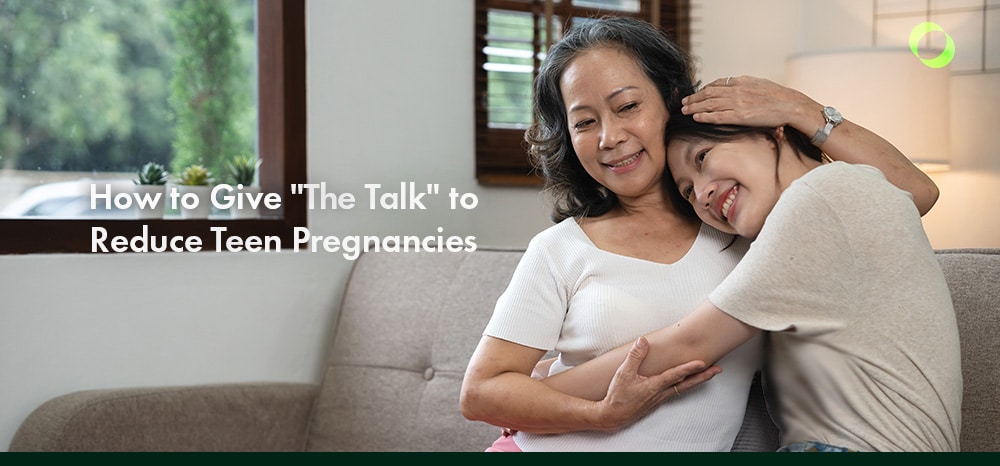“The talk.”
“The birds and the bees.”
There are many terms for discussing adolescent reproductive health with your kids. However, it has always been a controversial topic, due to the taboo of discussing sexual health education among the youth.
That said, it is precisely because of this lack of sex education that the country now faces a dual youth health crisis.
First off, teen pregnancies have significantly increased. According to the Philippine Statistics Authority (PSA), live births among girls aged 10-14 rose from 2,411 in 2019 to 3,343 in 2023.
Besides these alarming teenage birth statistics, there’s also the rising Human Immunodeficiency Virus (HIV) cases among the youth today.
According to the Department of Health (DOH), newly diagnosed cases among 15-25-year-olds have surged by 500%, with an average of 57 new infections per day in the first quarter of 2025.
Because of these, it’s more important than ever for parents to discuss reproductive health with their kids.
With the growth of work from home jobs, you now have more opportunities to do so.
Here’s how you can give “the talk” to your kids without making things awkward.
What “The Talk” Really Means in a Filipino Household
In the context of Filipino households, “the talk” isn’t just one sit-down conversation between parents and children.
Instead, Filipino families often hold many small talks over the years, triggered by school lessons, media, or their kids’ growing curiosity.
Traditionally, Filipino parents rely more on fear-based warnings that are rooted in religion when talking about reproductive health. Additionally, parents often use euphemisms in naming reproductive organs, which can cause further confusion.
However, this approach to early sexual activity can backfire, as it fosters shame and makes them less likely to ask questions and/or seek help regarding teenage pregnancies or sexually transmitted infections (STIs).
In contrast, studies show that quality Comprehensive Sexual Education (CSE), which combines accurate information with values like respect, responsibility, and consent, is better equipped to reduce the risk of teen pregnancies and adolescent HIV infection.
Furthermore, when taught properly, values-based guidance meshes well with the country’s predominantly Christian faith.
In short, you can still uphold the sacredness of sex while also teaching your kids protection, consent, and setting healthy boundaries.
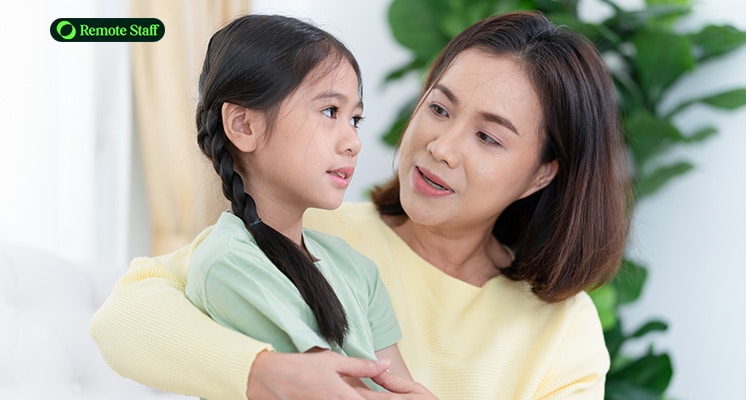
How to Talk to Your Child About Sex (By Age Group)
So, how can you discuss age-appropriate sex education with your child?
Ages 3-5: Introducing Body Awareness and Safety
Proper comprehensive sexual education (CSE) begins not during puberty, but during the ages of 3-5 years old.
Children start to develop body awareness, autonomy, and the ability to label their emotions during these years. Additionally, this stage also sets the foundation for safety, self-esteem, and boundaries:
- Use Anatomically Correct Terminology:
- Instead of using euphemisms to describe body parts, you should use the proper names like penis, vagina, and buttocks.
- Define Private Body Areas Using the “Bathing Suit” Rule:
- Explain that private parts are those covered by a swimsuit, and those areas are special and must remain covered, except for bathing or relevant medical care.
- Introduce the Concept of “Safe” vs. “Unsafe” Touch:
- Describe three types of touch:
- Safe touches feel loving or helpful.
- Unsafe touches hurt or make you feel scared, uncomfortable, or confused – anywhere, anytime.
- Unwanted touches are well-meaning but uninvited.
- Emphasize being in tune with feelings so children learn to rely on their instincts: “If it makes you feel scared, confused, or uncomfortable, it’s unsafe.”
- Describe three types of touch:
Ages 6-9: Respect, Privacy, and the Early Seeds of Consent
At ages 6-9 (Grades 1-3), your child is now beginning to explore personal boundaries and social relationships more deeply. Thus, it’s the perfect time to teach respect and privacy to them:
- Understanding and Respecting Personal Space:
- Start by teaching them that everyone’s personal space matters by modeling this in daily interactions, like knocking before entering their rooms or asking for permission before hugging friends or relatives.
- Privacy and Body Boundaries:
- Continue emphasizing the “swimsuit rule:” private parts are covered by the swimsuit and only certain adults (i.e., parents, doctors) may see them – and only with their permission.
- Early Consent: Asking and Listening:
- Model permission-based behavior by always asking your kids for consent before touching them (i.e., “May I touch you?”) and explain why.
- Use role-play scenarios and praise them for making respectful choices to help reinforce this behavior.
- Answering Early Questions About Babies:
- Use simple, accurate language like: “to make a baby, a sperm and an egg come together in the mother’s uterus.”
- Doing so satisfies their curiosity without overwhelming them with biological details.
- Furthermore, reinforce the idea that it’s normal for them to be curious and that they can always ask you these questions.
Ages 10-12: Pre-Teens and the Start of Biological Changes
This stage is marked by the onset of puberty, and with it come emotional and social shifts and a greater demand for hygiene.
Girls typically begin puberty around 10-10½ years, while boys at 11-12 years, though this can vary per child.
While they’re becoming more independent, they’ll still need your support to properly navigate this period of their lives:
- Teach Hygiene Clearly and Supportively:
- Model good hygiene habits by letting them see you washing, brushing, and applying deodorant.
- Normalize Body Changes:
- Explain that physical changes during puberty (voice cracking, pimples, breast growth) are normal and shouldn’t cause shame.
- Address Emotions and Social Pressures:
- Regularly check in with your child (i.e., ask how they’re feeling about school or the changes in their bodies) and offer reassurance and coping tips.
- Foster Open, Continued Communication:
- Studies show that adolescents who talk openly with their parents about health, puberty, and sexuality are more likely to avoid risky behaviors and seek help when needed.
Ages 13-15: Teens and Real Talk About Sex, HIV, and Peer Influence
Upon reaching early adolescence, teens are now navigating conflicting emotions, burgeoning independence, and intense peer dynamics.
Additionally, it is also during this period that they become more curious about sexual activities due to exposure online or through their friends.
Thus, this is the time they’ll need an honest and respectful conversation about online safety, contraception, and youth HIV and STI prevention:
- Explain Contraception Objectively:
- Discuss the various kinds of contraception, like condoms and pills, and how they prevent teen pregnancies.
- Emphasize the responsible use of contraceptives and avoid moralizing or alarmism during your discussion.
- Cover the Basics of HIV and STIs:
- Provide factual information on how HIV and STIs spread, how condoms help prevent infection, and ways to get tested and treated for them.
- Address Peer and Online Influence Directly:
- Adolescents this age are highly sensitive to their friends’ opinions; thus, discuss how to recognize healthy vs. unhealthy group expectations with them.
- Re-emphasize the importance of consent, especially when faced with peer pressure.
- Furthermore, you should also gently remind them to think more critically about the content they watch online.
Ages 16-19: Young Adults and Responsible Relationships
Despite the drop in teen pregnancy rates for Filipino women aged 15-19 (8.6% in 2017 to 5.4% in 2022), the rate remains persistently high.
Aside from dropping out of school, teen moms also face increased maternal health risks like eclampsia and infections.
Thus, as teens mature into adulthood, knowing more about reproductive health becomes even more paramount in reducing teen pregnancies and adolescent HIV infections:
- Inform Them of the Consequences of Early Pregnancy:
- Discussing the risks, both physical and economic, of teen pregnancies helps teens make smarter decisions when it comes to sexual activities.
- Talk to them about Family Planning:
- Aside from warning them of the consequences of early pregnancy, conversations regarding family planning help them understand bodily autonomy and make informed decisions.
- Help Them Discern Between Love and Lust:
- Knowing the difference between the two allows teens to make safer and more emotionally healthy relationship choices.
- Assist Them in Accessing Youth-Friendly Health Services:
- Teens often face stigma with seeking reproductive health services; they’ll need your reassurance that these services are confidential and reputable.
- Additionally, help them connect to these services by sharing contact details, clinic locations, and even offering to accompany them.
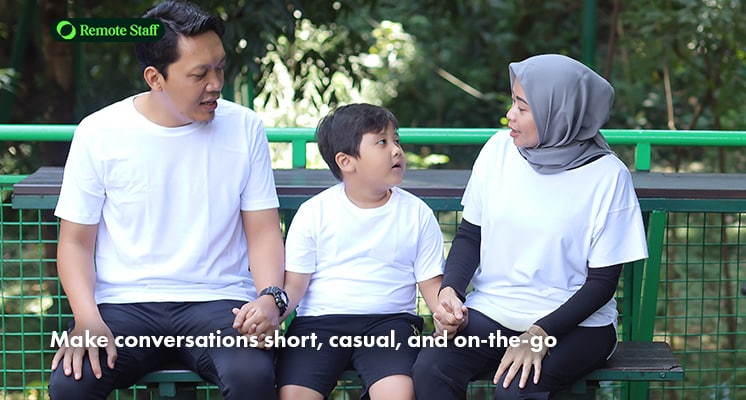
Tips for Making “The Talk” Easier for Filipino Parents
Struggling to initiate “the talk” with your kids? Here are some tips that can help:
- Choose the Right Timing and Setting:
- Make conversations short, casual, and on-the-go (i.e., during a car ride, cooking, or walking together) to avoid the tension of “big sit-down” talks.
- That said, formal structured moments (i.e., bedtime) can also work – whichever feels natural and comfortable to you and your children.
- Answer Awkward Questions as Honestly as Possible:
- If your child asks questions like: “Where do babies come from?,” resist the temptation to avoid it. Instead, provide an honest answer as best as you can.
- Additionally, avoid euphemisms and use the proper terminology to prevent confusion and build trust and understanding.
- Manage Shyness – Yours and Theirs:
- It’s normal to feel awkward discussing sex ed with your children; however, being honest about it shows it’s okay to feel shy, which promotes openness between you.
- Know When to Bring In a Counselor or Health Professional:
- If your teen asks detailed questions you’re not sure how to answer, a counselor, nurse, or doctor can offer medical accuracy and privacy.
Resources and Support Systems in the Philippines
Looking for additional assistance in teaching reproductive health to your adolescent children to prevent teen pregnancies? Here are some resources and public health campaigns that can help:
Government and Policy Support
- DOH-DepEd-POPCOM CSE-ARH Program:
- A collaborative initiative between the Department of Health (DOH), Department of Education (DepEd), and Commission on Population and Development (POPCOM).
- This integrates Comprehensive Sexual Education (CSE) into the K-12 curriculum and offers the following:
- Age-appropriate, values-based sex education materials and lesson plans,
- Training for teachers and school health personnel, and
- Referral systems to youth-friendly health services through barangay clinics.
Non-Governmental and Community Organizations
- Likhaan Center for Women’s Health:
- A Non-Government Organization (NGO) focusing on reproductive health and women’s rights. This organization offers:
- Community education and advocacy,
- Free counseling and family planning services (i.e., condoms via UNFPA), and
- IEC materials guiding parents on comprehensive and values-driven sex education.
- A Non-Government Organization (NGO) focusing on reproductive health and women’s rights. This organization offers:
- Bantay Bata 163 (An ABS-CBN Foundation):
- Offers a national hotline (call 163) for reporting child abuse and neglect.
- Aside from this, they also offer online counseling for parent-child relationship issues and referrals to services for children experiencing sexual exploitation and abuse.
Books
- “Ako ay May Kiki”/“I Have a Vagina” (Lampara Publishing):
- A bilingual (Filipino/English) book written by Glenda Oris and illustrated by Beth Parrocha aimed at young girls (5+), promoting:
- Correct anatomical language,
- Privacy and Autonomy, and
- Red flag awareness about unsafe touch – and advice on whom to tell.
- A bilingual (Filipino/English) book written by Glenda Oris and illustrated by Beth Parrocha aimed at young girls (5+), promoting:
- “Ako ay May Titi”/”I Have a Penis” (Lampara Publishing):
- Written by Genaro R. Rojo Cruz and illustrated by Beth Parrocha, this is the male counterpart (5+) to “Ako ay May Kiki”/”I have a Vagina,” focusing on proper genital care and respect for one’s sexuality.
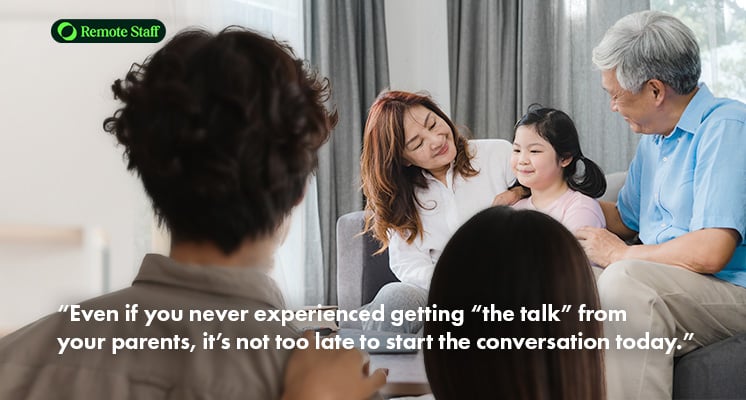
FAQ: Talking to Kids About Sex and Health in the Philippines
Here are some of the most common questions parents and educators ask regarding sex education and reducing the risk of teen pregnancies:
What if I Never Had “The Talk” Growing Up?
Even if you never experienced getting “the talk” from your parents, it’s not too late to start the conversation today by acknowledging this gap and doing the following:
- Use Simple, Age-Appropriate Language:
- Focus on what matters now – body changes, relationships, consent, and protection – and build from there.
- Normalize Questions and Curiosity:
- Let your child know that it’s okay to ask you about reproductive health anytime, even if the topic isn’t comfortable for both of you.
- Make It Ongoing – Not One-Off:
- This doesn’t have to be a formal “talk;” conversations between you can be short, casual, and triggered by real-life moments.
- Get Help When Needed:
- Don’t hesitate to consult counselors, health workers, and books like “Ako ay May Kiki”/“I Have a Vagina” and “Ako ay May Titi”/”I Have a Penis” if you need support.
Will This Encourage My Kids to be Sexually Active Early?
Not really.
On the contrary, Comprehensive Sexual Education (CSE) actually helps delay the first sexual encounter, and with it the risks of teen pregnancies and adolescent HIV infections.
Additionally, CSE helps increase condom use, leading to teens having safer sex when they’re ready.
How Do I Know if My Child is Ready for “The Talk?”
Here are some signs your child is ready for “the talk:”
- They ask increasingly curious questions,
- They ask about sensitive topics they’ve heard about or seen from peers, TV, or social media,
- Signs of emotional or biological development,
- They display a need for privacy or boundaries, and
- They consume media about sensitive topics.
What if My Child Asks Me Something I Can’t Answer?
Be honest about your lack of knowledge and offer to look it up together.
Additionally, remember to praise their curiosity to reinforce their confidence in asking you these kinds of questions in the future.
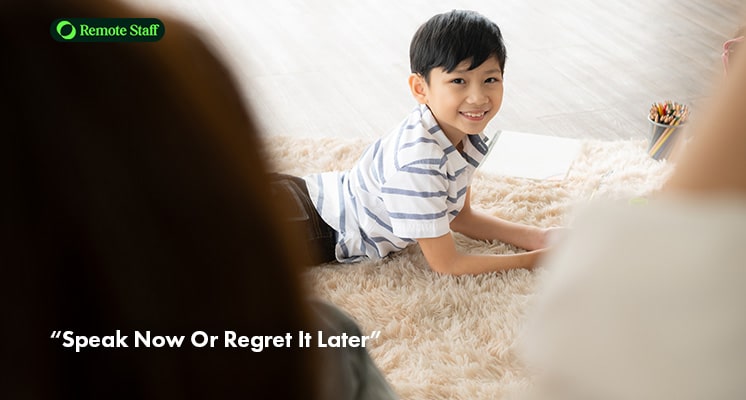
Speak Now Or Regret It Later
For many parents, reproductive health is a particularly difficult topic to discuss due to the taboo surrounding it.
Because of this, children turn to other, unscrupulous sources for answers. This has since led to an increase in teen pregnancies and rising HIV cases among the youth today.
Thus, there’s no better time to discuss reproductive health with your children than today.
It won’t be easy, but by following the tips above, you’ll have an easier time giving your kids “the talk” and helping them have a better understanding of reproductive health.
Do you want to spend more time with your children during this crucial phase of their lives? If so, Remote Staff is here to help.
Our jobs list contains plenty of internet-based careers to choose from, ranging from virtual assistant and online transcription jobs to online design and writing ones.
Ready to make the shift to a work from home setup? Click here. Good luck!

